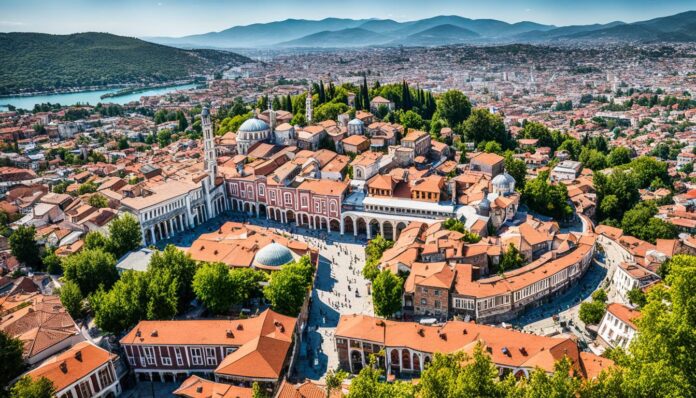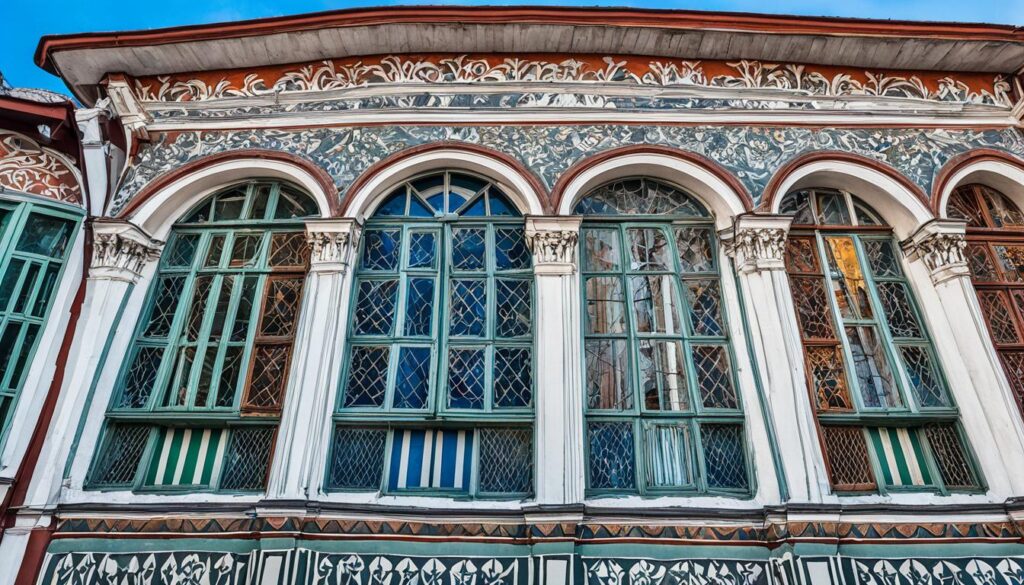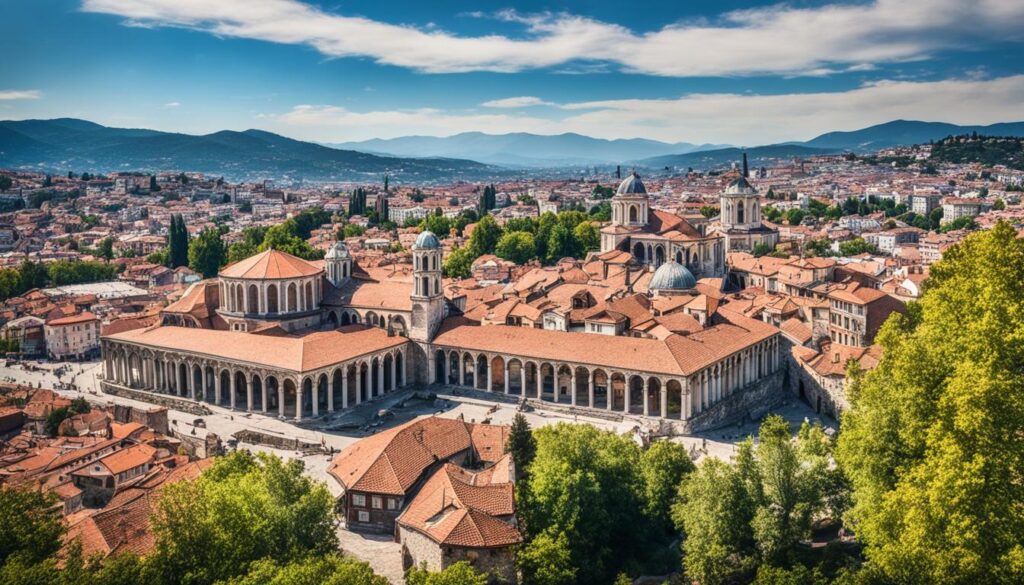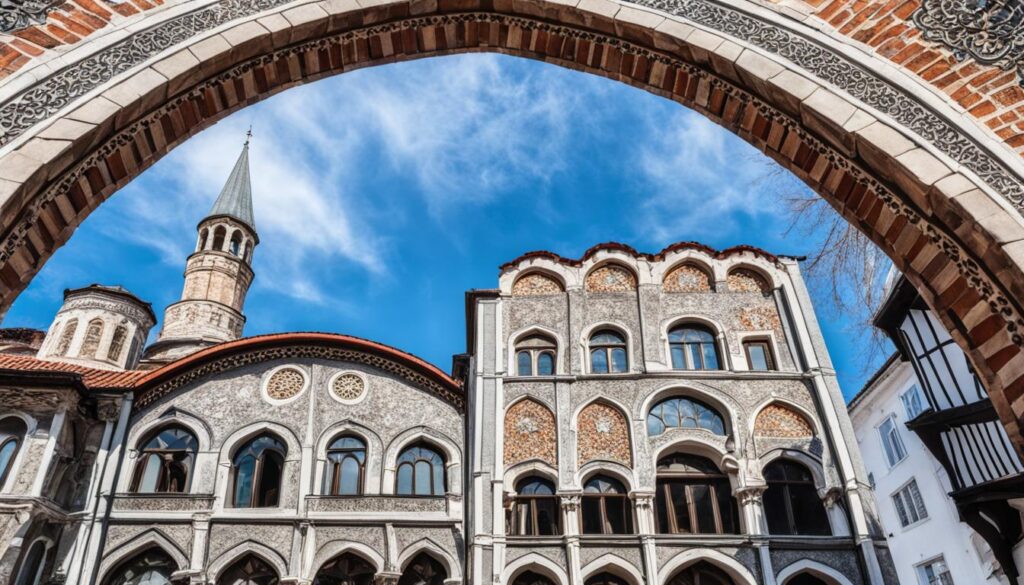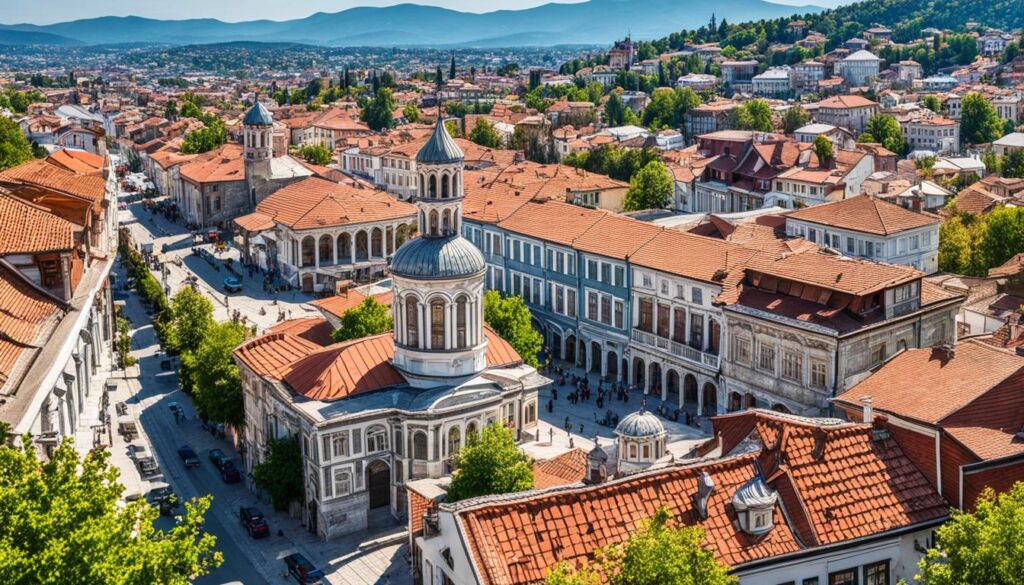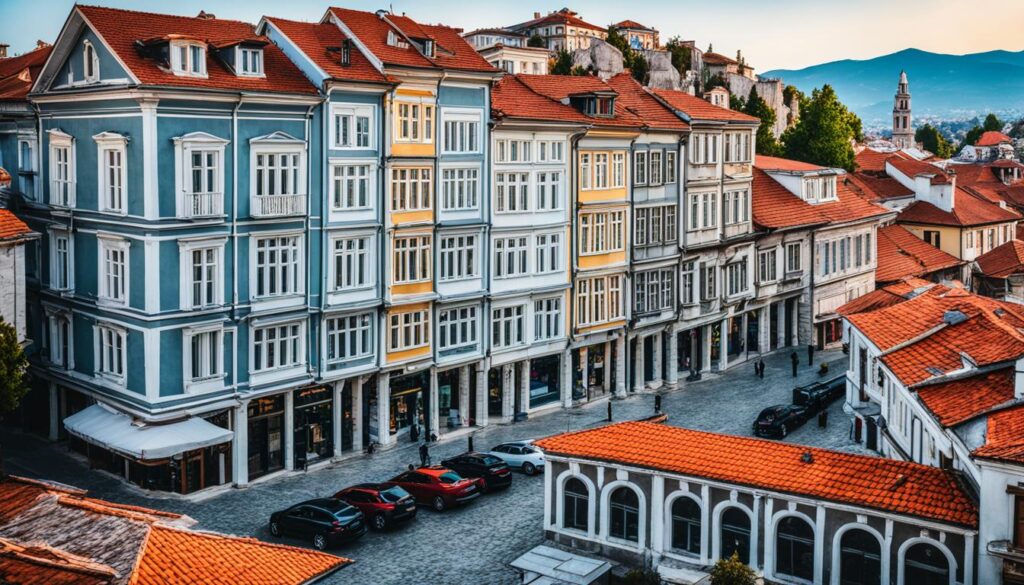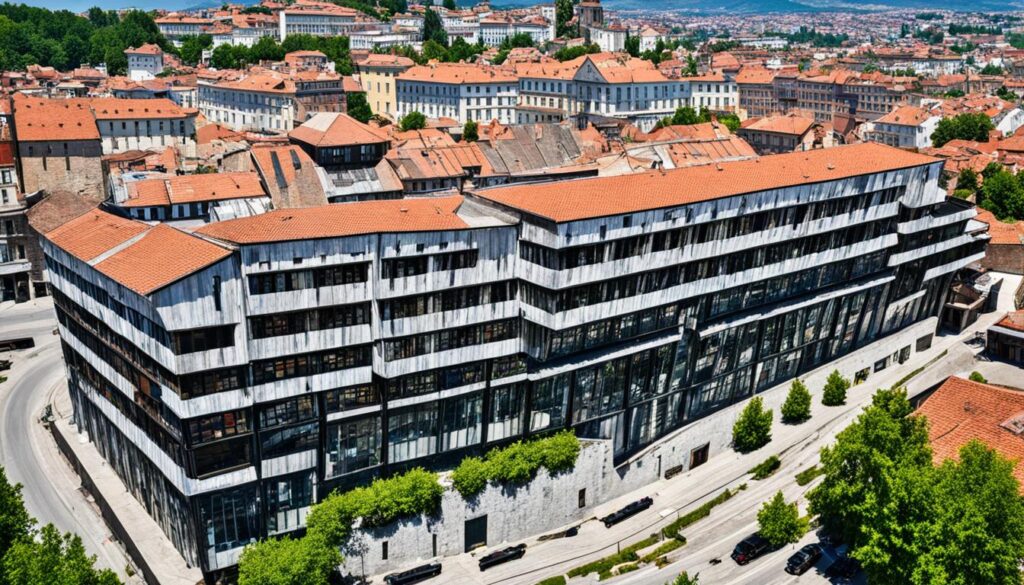Have you ever wondered how one city can hold so many beautiful buildings from different times? Plovdiv, in Bulgaria, shows us just that. It is full of amazing architecture from over the years. Plovdiv architecture takes us on a journey through history and beauty.
Walking in Plovdiv, you step through time. You see ancient Roman ruins, charming Ottoman homes, and new, bold buildings. Plovdiv’s mix of styles shows us how many cultures and art have influenced it. It’s a place where different times and stories meet in architecture.
This article will guide you through Plovdiv’s architectural treasures. We’ll visit old buildings that are reminders of the past, and the special sites that make Plovdiv stand out. Let’s see the amazing and unique architecture of this Bulgarian gem.
Ready to dive into the history and beauty of Plovdiv’s architecture? We’re about to explore the wonders of this incredible city. Get set to be amazed by its architectural treasures.
The Historical Buildings in Plovdiv
Plovdiv is a city filled with history. Its architecture tells a story of a rich past. Walking around, you’ll see many old buildings. They are a window into the city’s golden days. You can visit the Roman Amphitheater and the Ancient Stadium. These places show how grand things were in ancient times.
But the historical significance of Plovdiv doesn’t end there. You can also explore well-kept Ottoman houses. These houses are a peek into the Ottoman Empire’s splendid designs. In the old quarter of Plovdiv, you’ll be amazed. The houses there are beautifully decorated. They are a fine example of skilled craftsmanship.
Immerse yourself in the charm of the “Old Town” or “The Trap.” The narrow streets hide stunning Ottoman architecture. You’ll see amazing woodwork and bright colors. Every turn shows you a new piece of art. Exploring Plovdiv’s old buildings is truly special.
But it doesn’t stop there. Plovdiv’s beauty goes beyond Rome and the Ottomans. It’s a mix of many architectural styles. Neoclassical and Baroque together create a unique look. The Bulgarian Revival style is also mind-blowing. Plovdiv is a treasure for anyone who loves architecture.
Take a trip through Plovdiv’s history. See the Roman ruins, feel the Ottoman spirit, and enjoy the mix of cultures. Plovdiv is alive with its past. Its old buildings hold stories that are still being told today.
Roman Architecture in Plovdiv
The Romans made a big impact on Plovdiv’s look. Their buildings show off the amazing Roman style that the city once had. Today, we can still see remains that amaze anyone who visits. These leftovers are a big part of why Plovdiv’s history is so special.
The Ancient Forum
The Ancient Forum is a top example of Roman architecture in Plovdiv. This large square was the city’s main spot for business, politics, and gatherings in Roman times. Its detailed design and tall columns make you feel like you’re in the past, watching daily life. Walking there, you can almost feel the exciting vibe that filled it long ago.
The Eirene House
The Eirene House shows off Roman design in a beautiful way. It was a fancy home for someone important during the Roman period. Inside, look at the amazing art on the floors and walls, and the handmade decorations. You get a small taste of the luxury and style of Roman houses as you explore.
The Roman Stadium
The Roman Stadium is a sign of the Romans’ love for sport and fun. It was a big place for athletic games, with space for up to 30,000 people. Even though parts have been lost, it’s still easy to see how big and well-made the stadium was. Picture yourself in the middle, hearing the crowds and watching games. The stadium reminds us of the exciting days in Roman Plovdiv.
Exploring Roman architecture in Plovdiv feels like traveling in time. The Ancient Forum, the Eirene House, and the Roman Stadium are real treasures. They tell the story of Plovdiv’s long history and its rich culture.
Ottoman Architecture in Plovdiv
The Ottoman Empire has shaped Plovdiv’s architecture greatly. When you walk through Plovdiv’s “Old Town” or “The Trap,” you are greeted by stunning Ottoman buildings.
Ottoman architecture in Plovdiv is known for its beautiful details. You’ll see this in the design of houses, mosques, and hammams. It shows the amazing skill and creativity of Ottoman architects.
The homes in the Old Town are particularly beautiful. They have bright frescoes, wooden bay windows, and pretty balconies. They give us a peek into how the wealthy Ottoman families lived. These homes mix influences from both Eastern and Western cultures.
The Dzhumaya Mosque stands out among Plovdiv’s Ottoman buildings. Its minaret and detailed interior are stunning examples of Ottoman Islamic design. They show the beauty of this architectural style.
The hammams, or bathhouses, in Plovdiv are also impressive. You can take a break and enjoy their beauty. The dome ceilings and marble finishes were made with great care.
Immerse yourself in the vibrant and rich atmosphere of Plovdiv’s Ottoman architectural heritage. The blend of elegance and grandeur will transport you to a bygone era of imperial splendor.
Key Features of Ottoman Architecture in Plovdiv
| Features | Description |
|---|---|
| Ornate Decoration | Ottoman buildings in Plovdiv are known for their intricate designs and decorative elements, including colorful frescoes, Islamic geometric patterns, and ornamental carvings. |
| Delicate Balconies and Bay Windows | The houses in the Old Town boast elaborate wooden bay windows and balconies, providing a unique architectural flourish to the buildings. |
| Islamic Influences | Ottoman architecture in Plovdiv incorporates Islamic design elements, such as minarets, domes, and calligraphy, showcasing the cultural and religious heritage of the Ottoman Empire. |
| Use of Natural Materials | Ottoman buildings in Plovdiv feature the use of natural materials, such as stone and wood, emphasizing a connection to the surrounding natural environment. |
Visiting Plovdiv is like traveling through time. You’ll see Ottoman architecture next to Roman and Bulgarian buildings. Experience the unique beauty of Plovdiv’s Ottoman structures and the lasting influence of the Ottoman Empire.
Thracian Architecture and its Influence
Long before Romans and Ottomans, the Thracians called the Plovdiv region home. Their architecture left a mark on the city’s later building styles. You can see this influence in everything from ancient Thracian sanctuaries to their strong walls.
The Rich Legacy of Thracian Architecture
The Thracians were skilled in crafting stone and building. They made stunning sanctuaries and forts. These structures still stand, showing off their cleverness.
The Thracians built magnificent temples and fortresses, blending elements of simplicity and grandeur. Their architectural style captivates with its use of intricate stone carvings and geometric patterns.
Perperikon is among Plovdiv’s famed sanctuaries. It reflects a blend of Thracian architecture with nature. Inside its cliffs are rock-cut chambers and tombs.
Thracian fortification also influences Plovdiv’s ancient walls. These walls, made of big stones, show their skill in defense.
Architectural Evolution: Thracian to Roman
Roman architects learned from the Thracians. The Thracians’ work impacted the Romans’ buildings. This created a mix of Thracian and Roman architecture.
The Roman Amphitheater is a great example. It blends Roman engineering with Thracian theater design. This reflects the rich mixture of the two cultures.
Preserving Thracian Architecture in Plovdiv
Plovdiv works hard to protect its Thracian buildings. These efforts help keep the city’s history alive for future visitors. It’s a way to honor the past.
By sharing the story of Thracian architecture, Plovdiv honors its ancient roots and enriches the cultural tapestry of the city.
A Glimpse into the Past
Visiting Thracian sites in Plovdiv is like going back in time. It’s a chance to admire their art and skills. From sacred places to strongholds, each structure preserves the Thracians’ story.
Plovdiv Architectural Styles Throughout History
Plovdiv’s buildings tell an amazing story. They show different styles from many ages and cultures. You can see Neoclassical, Baroque, and Bulgarian Revival architecture in Plovdiv.
These styles make Plovdiv special and full of history. It’s like walking through a living museum of architecture.
Neoclassical Architecture
The Neoclassical style is from the late 1700s and early 1800s. It looks to ancient Rome and Greece for ideas. Neoclassical buildings in Plovdiv include the Noble Casino and the City Art Gallery.
Baroque Architecture
Baroque design is from the 1600s. It’s known for being very detailed and dramatic. Buildings like the Balabanov House and the Church of St. Constantine and St. Helena show off Baroque style in Plovdiv.
Bulgarian Revival Architecture
The Bulgarian Revival style is from the 1800s. It combines Bulgarian, Ottoman, and European features. Plovdiv’s Old Town has many pretty Revival houses to see.
The diversification of architectural styles in Plovdiv showcases the city’s vibrant history and the fusion of different cultural influences that have shaped its identity.
These styles all blend together beautifully in Plovdiv. You can see history at every turn, like in the Old Town and Kapana.
Take a walk and appreciate Plovdiv’s beauty. Each building has a story to tell about the city’s past.
Architectural Styles in Plovdiv – A Summary
| Architectural Style | Key Features | Notable Examples |
|---|---|---|
| Neoclassical | Symmetry, clean lines, proportion | Noble Casino, City Art Gallery, House of Balabanov |
| Baroque | Elaborate ornamentation, dramatic shapes | Balabanov House, Church of St. Constantine and St. Helena |
| Bulgarian Revival | Traditional Bulgarian elements, colorful facades, wooden balconies | Old Town Revival houses |
Modern Architecture in Plovdiv
Plovdiv is famous for its old buildings but also shines with new architecture. Discover how old and new mix in this lively city.
The Plovdiv Roman Theater’s update is a top example. It merges modern style with history, making the theater a spot for events and shows.
Walking around, you’ll see many new, futuristic buildings. They show off the city’s focus on moving forward with cool designs.
Keep an eye out for buildings that pop with their different looks and bright colors. They make Plovdiv more interesting for fans of design.
Modern architecture in Plovdiv is all about new ideas mixing with history and function. It’s about making a city both beautiful and useful.
Admire the sleek office buildings and the colorful living spaces. Each one adds something special to Plovdiv’s modern vibe.
As you explore Plovdiv, notice how tradition and today blend so well. It’s a city where old and new stand together, creating something unique.
Architectural Preservation Efforts in Plovdiv
Plovdiv’s old buildings tell a lot about its history. Saving them needs a lot of work from different groups and organizations. They work hard to keep the city’s special places looking like they did long ago.
The Plovdiv Architectural Preservation Society
The Plovdiv Architectural Preservation Society (PAPS) is a key player in keeping the city’s buildings safe. It’s made up of people who love Plovdiv and its old structure. PAPS helps make plans to protect and fix up the buildings. They also teach people why these old buildings matter a lot.
Restoration Projects
Plovdiv has many old buildings that have been brought back to life. The Ancient Roman Theatre, for example, is over 1,800 years old. It’s been fixed up to look much better. Now, it’s a spot for concerts and plays, bringing the city’s culture to life.
In addition, the Djumaya Mosque has also been carefully restored. This 700-year-old beauty was worked on to keep it looking great. The goal was to ensure it could still be used for worship. This shows how different cultures in Plovdiv live together peacefully.
Adaptive Reuse Projects
New plans to use old buildings have become a big deal in Plovdiv. These plans change the use of a building while keeping its special look the same. Kapana is a good example. It used to be a quiet area and now it’s full of life, with places to see art or have coffee.
The Tobacco Townhouses show how important keeping old buildings can be. They were once part of making tobacco. Now, they’re a place to see art and creativity grow. This mix of old and new helps Plovdiv’s culture stay strong.
Collaborative Efforts
To save Plovdiv’s old buildings, everyone needs to work together. The city government and groups like PAPS and people living here all do their part. They help make sure projects to save the old buildings are a success.
The work isn’t just about making old buildings look nice. It’s about keeping the story of Plovdiv alive. This connects everyone to the city’s history and culture.
“Preserving Plovdiv’s architectural treasures is not just about maintaining beautiful buildings; it’s about honoring our past and shaping our future. These landmarks connect us to our history, culture, and identity as a city.” – Sofia Ivanova, Architect
“Architecture is not just about structures; it’s about storytelling. Through preservation, we tell the stories of those who came before us, bridging the gap between the past and the present.” – Stoyan Petrov, Heritage Conservationist
Preservation for Future Generations
Keeping Plovdiv’s old buildings safe means future kids can learn from them. The buildings, from Roman times to Ottoman rule, all have a story. Saving them means we can all enjoy their beauty and learn from their history.
Exploring Plovdiv’s Unique Architectural Landmarks
Explore the unique architectural landmarks of Plovdiv. The city is filled with special buildings that show off Plovdiv’s creativity and style.
The Kapana Creative District is a must-see. It was once a forgotten area but has now transformed into a lively spot. You’ll find it packed with colorful buildings, cool cafes, and art studios. This mix of new and old makes it a place that’s fun for everyone.
Don’t miss the Tobacco Townhouses in the Old Town. These 19th-century homes were for wealthy tobacco sellers. They are beautifully designed, showing Plovdiv’s past wealth and style.
Seeing the Dzhumaya Mosque is also a highlight. It was built in the 15th century and has a unique look. The mosque mixes Ottoman and Eastern styles, showing Plovdiv’s varied influences.
Discover the captivating allure of Plovdiv’s architectural landmarks. Tradition and innovation mix here to make a unique cityscape. From Kapana’s lively streets to the elegant Tobacco Townhouses and the beautiful Dzhumaya Mosque, it’s a world of beauty.
| Landmark | Description |
|---|---|
| Kapana Creative District | A vibrant neighborhood with colorful buildings, trendy cafes, and creative studios. |
| Tobacco Townhouses | Beautifully restored 19th-century buildings showcasing Plovdiv’s architectural heritage. |
| Dzhumaya Mosque | A stunning mosque blending Ottoman and Oriental design, symbolizing architectural harmony. |
Get lost in the enchanting world of Plovdiv’s architectural wonders. Feel the city’s history and creativity in these amazing spots. Each one has a story to share with you.
Architectural Highlights in Plovdiv Surroundings
The city center of Plovdiv is famous for its beautiful architecture. But the areas around it have their own hidden gems. These ancient buildings show a lot about the culture and history of the region.
The Roman Villa Armira is a must-see in the Rhodope Mountains. It’s a great example of Roman architecture. You can see stunning mosaic floors and well-preserved frescoes.
The Bachkovo Monastery, from the 11th century, is another place not to miss. It mixes Byzantine, Bulgarian, and Ottoman styles. The monastery is known for its beautiful woodcarvings and colorful frescoes.
| Architectural Highlight | Description |
|---|---|
| Roman Villa Armira | Ancient Roman villa located in the Rhodope Mountains, showcasing exquisite architecture with mosaic floors and frescoes. |
| Bachkovo Monastery | 11th-century monastery featuring a unique blend of Byzantine, Bulgarian, and Ottoman architectural styles. |
These sites add a lot to Plovdiv’s history and show the variety of its architecture. Whether you love Roman design or the mix at Bachkovo Monastery, you’ll love these places. They help everyone see the great architecture outside Plovdiv’s center.
Explore the beauty and history of Plovdiv’s surroundings. It’s a mix of stunning nature and ancient sites. This mix makes for an unforgettable journey through Plovdiv’s architectural past.
Capturing the Essence of Plovdiv Architecture
Enjoy the beauty of Plovdiv’s architecture with photographs and stories. This city is known for its diverse and rich architecture. It’s a real treat for those who love history and design. The buildings reflect many different styles over the years.
In Plovdiv, you’ll see ancient Roman ruins, Turkish homes, and new buildings blend perfectly. Each place has a story to tell about the city’s culture and past.
“Plovdiv’s architecture shows its colorful history and hopeful future. Mixing old and new creates a special feeling here.” – Local resident
Explore the Roman Amphitheater for a look back at Roman times. The Old Town’s streets and architecture mix Turkish and Bulgarian styles beautifully.
See the city’s modern side with places like the Plovdiv Roman Theater. It’s a sign of the city’s bright cultural future. Also admire the new buildings with their interesting designs.
Exploring the Stories Behind Plovdiv’s Architecture
Discover the deep stories of Plovdiv’s buildings. Find out about the architects and events that made them. From ancient ruins to hidden house features, every building has its own story.
By learning about Plovdiv’s architecture, you’ll see its special place in the world. The colors and mix of styles make it truly unique.
Preserving the Architectural Legacy
Protecting Plovdiv’s old buildings is very important. Local groups and people work hard to keep these historic sites. They use restoration and education to protect the city’s legacy.
When you visit Plovdiv, take in its amazing architecture. Look at the details and hear the stories. Plovdiv is a place with a lot of history and beauty.
Conclusion
The buildings in Plovdiv show how its history is rich and varied. You can see remains from Roman times, stunning Ottoman structures, and bits of Thracian architecture. This makes Plovdiv a place where you can walk through ages.
Plovdiv’s architecture is a mix of many styles. There are grand Neoclassical and Baroque buildings. You’ll also find beautiful Bulgarian Revival houses. The new buildings fit in well, showing Plovdiv’s lively mix of old and new.
It’s critical to keep Plovdiv’s architectural gems safe. This way, kids in the future can enjoy them too. Many groups and projects work hard to protect these pieces of history.
When you visit Plovdiv, you’ll be amazed by its architecture. Explore historic sites and enjoy the beauty of Ottoman and Thracian styles. You’ll see how old and new parts of the city come together. Plovdiv is waiting to give you a wonderful journey through its architecture.




























